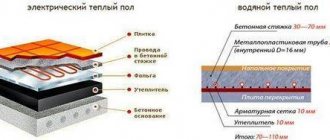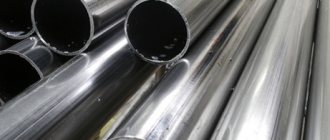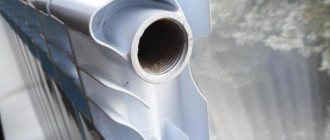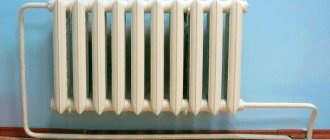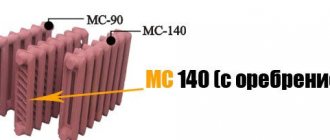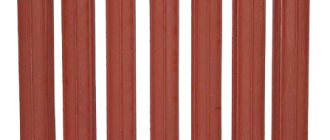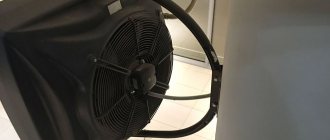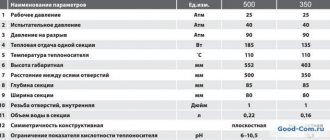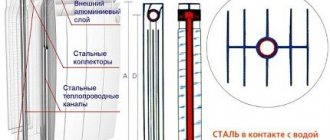Here you will learn:
- Radiators from the Prado brand
- Produced model ranges
- Hygienic rulers
- Equipment for installation and connection
- Owner reviews
Radiators are fairly simple heating devices. But their choice comes with some subtleties. By choosing batteries from a little-known brand, consumers risk encountering numerous difficulties, from low efficiency to leaks. By choosing Prado radiators, you can forget about all the problems - at least, this is what many users who have managed to use this equipment think. Our review will be devoted to these radiators.
Design
Prado batteries are panel heating devices. They consist of two stamped blanks, which are molded under a press from a steel sheet. The standard sheet thickness is 1.2 mm; upon request, modifications are made from steel 1.4 mm thick (the model name contains the letter “T”). When stamping, two horizontal channels are formed - at the top and bottom, and vertical - 3 pieces per 10 cm of length.
Panel radiators look good
Along the vertical channels, two workpieces are connected by spot welding (welding is done from the back side and is not visible on the front panel). Then they are welded along the perimeter with a continuous seam. To increase heat transfer, ribs formed from a steel sheet 0.4-0.5 mm thick can be welded to the back side of such a panel. The shape of the ribs resembles the letter “P”.
Depending on the number of panels and the presence or absence of additional finned plates between them, panel radiators of the same size have different thermal power, as well as depth and weight. The number of panels and additional convective fins is displayed in the name of the heating device. Type 10 means that there is only one panel with coolant, type 20 - two panels, 11 and 21 - one and two panels with one row of fins. The maximum number of panels and ribs is 3.
The height of Prado steel radiators is 300 mm and 500 mm, width from 400 mm to 3000 mm, depth depends on the type and varies from 72 mm to 174 mm.
Types of panel steel radiators and their brief description (Click on the picture to enlarge it)
Aluminum heating equipment
Although many experts suggest that buyers purchase Raden bimetallic heating radiators, this is not a mandatory rule. Aluminum as a manufacturing material is quite good in terms of thermal output and a number of other important characteristics. If the work environment allows, the application is justified. Some rules still need to be taken into account.
Aluminum radiators from Radena are used in systems based on water heating. Buildings – administrative, residential, public. Low-rise buildings are suitable.
Manufacturing process and cost
It's time to talk about more serious things. Let's start with a little information, which is that Raden aluminum heating radiators are made from a number of sections. The latter are cast under high pressure. Then they are combined into a single whole. For this purpose, steel nipples and special types of gaskets are used.
Aluminum radiator Radena 500.
Products are painted using epoxy polyester. A couple of layers are applied. If you are well versed in various technical subtleties, we will add that when creating a protective coating, two methods are used. The first is cataphoresis. The second is electrostatic spraying. We are talking about enamel in powder form. At the very end, the product is coated with a paint composition that belongs to class A.
You need to know the following - both the manufacturing and painting of Radena aluminum radiators are done at an acceptable level. In total, there are two types of aluminum products to choose from – R350 and R500. Price R350 – from approximately $11.3 per section, R500–$11.8.
Specifications
The basic properties of R350 and R500 are not very different. We will consider the first option. If the R500 is different in some way, we will explain it separately. Normal operation of radiators is guaranteed at a coolant operating pressure of 16 atm. As for the test one, it is 24 atm. The burst pressure is 50 atm.
The thermal output of one section is very high - 165 W. The R500 model has slightly more - 192 W. In order for heating equipment to last a long time, the coolant temperature should not exceed 110 degrees. Plus per liter of working fluid more than 0.02 mg of oxygen is prohibited
It is worth paying attention to the pH. Acceptable value – from 6.5 to 9
One section of the product holds 0.275 l (R500–0.330 l). The weight also varies to some extent. R350 – 1.05 kg, R500 – 1.35 kg. The section height is 431 mm and 581 mm, respectively, for different models. The center distance is 350 mm and 500 mm (hence the indices in the name). The remaining indicators are again the same. For example, the depth of the radiator section is 85 mm. Width – 80 mm. The inlet holes for connection have a diameter of 1 inch. White color.
We believe that the information provided is more than enough to superficially evaluate aluminum products. Let's move on to a more interesting option. We are talking about Radena bimetallic heating radiators, which are even more versatile.
Range
Three lines of heating devices are produced:
- Prado Classic (Prado Classic) - radiators with side walls and upper grilles for releasing heated air. Connection - lateral, thread diameter G ½.
- Prado Universal (Prado Universal) have two connection options. Each battery has four side inputs and a bottom connection. All pipes are ½” in diameter. The bottom connection can be in the right or left version. Also, radiators of this line are supplied equipped with a built-in thermostat.
- Prado Classic Z and Prado Universal Z are options without casings and additional ribs, side and top covers. They are also called sanitary, as they meet sanitary standards for medical institutions (there are no ribs or lids, so they are easy to clean).
In the standard version, all radiators are made of 1.2 mm thick steel; in 1.4 mm versions, the letter “T” is added to the names. For example, Prado Classic T, Prado Universal Z T.
This is a model • Prado Universal with thermostatic valve
Prado Classic can be used in systems with any type of wiring; Prado Universal are intended for use in two-pipe systems. They are equipped with a thermostat with high hydraulic resistance. For installation in single-pipe systems, a special thermostat with low hydraulic resistance is required. If you plan to install a device of this type in a one-pipe system, purchase the “Classic” option and install a thermostat with a large flow area.
Nuances of installation work
The side pipes for connecting pipelines are located on both sides of the unit and have a ½” thread. Different connection types can be used.
But if the length of the device is more than 1400 millimeters, the lower saddle and side one-way connections will be ineffective. If the radiator is long enough, it is recommended to make a diagonal connection, which assumes that the supply is made from above on one side of the device, and the outlet from the opposite bottom.
In the case of using a bottom connection, it is also called a bottom connection, it must be taken into account that the supply is the second entrance from the side edge, and the “return” is located at the edge. It is forbidden to swap them, since a tube is welded to the supply inlet at the factory, transporting the heated liquid to the upper manifold, after which it is distributed over all vertically located channels.
To mount Prado steel radiators, the manufacturer advises using the brackets included with the units. These fasteners were specially designed for them.
The brackets must be inserted into the grooves located on the back wall of the steel panel. Depending on the length of the device, there are 2 or 3 of them. It is possible to install the structure on legs, and not just fix it on the wall. However, branded supports must be ordered individually.
Installation is performed in a certain sequence:
- On a flat, pre-prepared wall surface, mark the places where it is planned to install fasteners.
- The brackets need to be unpacked.
- The fastening points are reinforced with dowels or a special solution.
- An automatic air vent or a Mayevsky valve, a thermostat and plugs must be installed on the heating device, and if necessary, adapters are used.
- On the radiator, in the places where it is mounted on the brackets, open the packaging and place the device on the fastening elements.
- Connect the pipes supplying the coolant and discharging it.
- All plastic film packaging is removed after completion of finishing work in the room.
To prevent air locks from appearing after installing Prado radiators with a bottom connection while filling the heating system, this should be done through the “return” by opening the thermostats.
Features of Prado radiators
Prado steel panel radiators are used in water heating systems. The design of the radiators consists of rectangular steel sheets welded together.
The material is based on 1.2 mm thick sheet steel. After cutting the sheets to specific sizes, they are stamped to obtain the desired shape. Then the elements and transverse seam are welded. The radiator can contain 1-3 rows of panels. Additionally, to increase heat transfer, corrugated steel ribs can be welded to the panels. The air outlet grille and side walls give the product an aesthetic appearance . Depending on the number of installed fins and panels responsible for heat transfer, the power of the radiator is determined. Panel radiators are produced in white, but upon request they can be made in any color.
Panel radiators made of steel are produced in different sizes: height - 300 mm and 500 mm, depth - 80-200 mm (depending on the number of rows of panels and the presence of fins), length - 400 mm - 3 m.
Additionally, panel radiators can be equipped with a built-in thermostat that maintains the optimal temperature in the entire room. For models without it, you can purchase a thermostat separately.
Steel radiators can withstand operating pressure of 9 atmospheres, and test pressure of 13.5.
Radiators can be connected in two ways - side and bottom. The lower connection makes it possible to remove external pipes in order to improve the interior of the room.
Each type of radiator is made in two versions, differing in connection diagram:
- Prado Classic - side eyeliner. Equipped with 4 connecting pipes.
- Prado Universal - lower eyeliner. Equipped with a built-in thermostatic valve for a 2-pipe heating system.
Why is it profitable to make heated floors?
The main advantage of heated floors over all other types of heating is that they are hidden from view and are ideal for families with small children. In addition to the fact that babies can crawl safely, they will not get burned on heat sources that are securely hidden under the finishing coating. There are no drafts in the room where heated floors are installed.
Warm floors reduce heating costs in houses with very high ceilings, where it is difficult to rationally organize heating of the entire volume of the room. In apartments located on the ground floor, above damp, cold basements, heated floors will provide a comfortable microclimate.
In addition, they do not dry out the air, which is especially appreciated by sensitive people prone to allergies. When heated floors are an autonomous type of heating, they will help out on cold days in the off-season. Ceramic tiles, even with the best heating system, remain cold, and here the use of warm floors will help out.
Thus, the decision to install heated floors is for the benefit of the health of family members
It is important to choose which system is best to use
Types of Prado radiators
There are 6 types of steel panels:
- Type 10 - depth 61 mm, has one row of panels without fins. Price for Classic from 900 rubles, Universal from 1600 rubles;
- Type 11 - 74 mm deep, has one row of panel with one row of fins welded to the back of the panel, as well as an air outlet grille and side walls. Classic from 1300 rubles, Universal from 1900 rubles;
- Type 20 - 74 mm deep, has two rows of panels without fins, an air outlet grille and side walls. Classic price from 1340 rubles, Universal from 2000 rubles;
- Type 21 - 74mm deep, has two rows of panels with one row of fins welded to the back of the front panel, as well as an air outlet grille and side walls. Classic from 1600 rubles, Universal from 2340 rubles;
- Type 22 - 100 mm deep, has two rows of panels with two rows of fins, which are welded to each panel on the inside, as well as an air outlet grille and side walls. Classic from 2400 rubles, Universal from 3500 rubles;
- Type 33 - 160 mm deep, has three rows of panels with three rows of fins that are welded to each panel on the inside, as well as an air outlet grille and side walls. Classic from 2850 rubles, Universal from 3580 rubles.
All six types include brackets and mounting hardware for wall mounting .
Produced model ranges
Prado steel heating radiators are presented on the market in several model ranges. There are only four of them, so there will be no agony of choice - everything is extremely easy and simple. For use in children's rooms and medical buildings, it is recommended to pay attention to hygienic samples.
Classic with side liner
The Prado Classic radiator will be a reliable and inexpensive solution for heating your home; the equipment warranty is 10 years.
The Classic series is characterized by a side coolant supply and is equipped with protective side elements and an upper grille. These radiators can be operated at temperatures up to +120 degrees and pressure up to 9 atmospheres. Scope of application – heating of buildings for any purpose (from residential to industrial). The series includes the following types - 33, 30, 22, 21, 20, 11 and 10, height - 300 and 500 mm, length - from 400 to 3000 mm.
Thermal power ranges from 210 to 4874 W for 300 mm high models and from 324 to 7656 W for 500 mm high models. Connection methods: side, bottom side or diagonal, including using thermostatic valves.
Universal with bottom eyeliner
This model range from the Prado company includes radiators of 10, 11, 20, 21, 22, 30 and 33 types. The height of the cases is 300 or 500 mm, length - from 400 to 3000 mm. The maximum operating temperature for the model range is +120 degrees with a pressure in the circuit not higher than 9 atmospheres. The difference from the previous line is the bottom connection, convenient in cases where the heating system pipes are recessed into the floors. In terms of other characteristics, both model ranges are similar down to the smallest detail.
Fastenings
| A* | B | C | |
| 400 | 99/104 | 166 | — |
| 500 | 132/137 | 200 | — |
| 600 | 132/137 | 300 | — |
| 700 | 132/137 | 400 | — |
| 800 | 132/137 | 500 | — |
| 900 | 132/137 | 600 | — |
| 1000 | 132/137 | 700 | — |
| 1100 | 132/137 | 800 | — |
| 1200 | 232/237 | 700 | — |
| 1300 | 232/237 | 800 | — |
| 1400 | 232/237 | 900 | — |
| 1500 | 232/237 | 1000 | — |
| 1600 | 232/237 | 1100 | — |
| 1700 | 232/237 | 1200 | — |
| 1800 | 232/237 | 1300 | 667 |
| 1900 | 232/237 | 1400 | 717 |
| 2000 | 232/237 | 1500 | 767 |
| 2200 | 232/237 | 1700 | 867 |
| 2400 | 232/237 | 1900 | 967 |
| 2600 | 232/237 | 2100 | 1067 |
| 2800 | 232/237 | 2300 | 1167 |
| 3000 | 232/237 | 2500 | 1267 |
| L | A* | B | C |
| 400 | 50 | 300/166 | — |
| 500 | 150 | 200 | — |
| 600 | 150 | 300 | — |
| 700 | 150 | 400 | — |
| 800 | 150 | 500 | — |
| 900 | 150 | 600 | — |
| 1000 | 150 | 700 | — |
| 1100 | 150 | 800 | — |
| 1200 | 250 | 700 | — |
| 1300 | 250 | 800 | — |
| 1400 | 250 | 900 | — |
| 1500 | 250 | 1000 | — |
| 1600 | 250 | 1100 | — |
| 1700 | 250 | 1200 | — |
| 1800 | 250 | 1300 | 650 |
| 1900 | 250 | 1400 | 700 |
| 2000 | 250 | 1500 | 750 |
| 2200 | 250 | 1700 | 850 |
| 2400 | 250 | 1900 | 950 |
| 2600 | 250 | 2100 | 1050 |
| 2800 | 250 | 2300 | 1150 |
| 3000 | 250 | 2500 | 1250 |
L-length of radiator
A,B,C - Bracket distance
*-Below the decimal line are options for installing brackets with a small shelf to the wall.
Scope and technical characteristics
Prado panel radiators are made of steel, which is susceptible to corrosion. Therefore, they can only be installed in closed systems. In such systems, steel batteries perform well and last a long time.
When planning a heating replacement in multi-story buildings, you must first check with the operating organization about the system parameters for your home. The type of heating devices that you can install in your apartment depends on its condition.
Today, high-rise buildings are heated according to several schemes. If the house is connected according to an independent circuit or has its own water treatment system, then radiators can be installed from any material, including steel. If the system is dependent and the house is connected directly, then it is necessary to clarify the parameters of the coolant and its quality.
View from above
Prado steel radiators can be installed in systems with the following indicators:
- coolant temperature not higher than +120oC;
- working pressure: with a sheet thickness of 1.2 mm - 0.9 MPa;
- sheet 1.4 mm - 1.0 MPa;
- with a sheet thickness of 1.2 mm - 1.25 MPa;
- with a sheet thickness of 1.2 mm - 2.25 MPa;
If panel radiators are not suitable for any indicator, you need to install a different type - either cast iron or bimetallic.
The amount of contaminants in the coolant is also very important. If mud traps and filters are installed on the riser, their number is most likely small. But if the connection to the centralized network is direct, then using panel radiators is not recommended. The fact is that vertical collectors for the passage of coolant have a small cross-section. The presence of large amounts of suspended particles can cause them to become clogged. Since this type of heating device is a non-demountable structure, it will be difficult to do anything if the circulation is disrupted.
In general, to prevent siltation when connecting to centralized networks, it is recommended to install additional filters and mud collectors on the supply before entering the radiator.
Stopcocks
The simplest device that can change the temperature of the batteries is a shut-off valve. It can, at the most primitive level, control the supply of hot water from the heating system of the house. The shut-off valve has the form of a ball valve, which has only two positions:
p, blockquote 9,0,1,0,0 –>
A significant disadvantage of using a shut-off valve is the need for constant manipulation. It is impossible to create a stable temperature regime using this device.
p, blockquote 10,0,0,0,0 –>
You can use a tap to regulate the temperature of the radiator only if a bypass (bypass pipe) is installed in front of the battery. Otherwise, a closed tap will disrupt the circulation of the coolant in the general house system.
p, blockquote 12,0,0,0,0 –>
Hygienic rulers
Traditional radiators, including those from Prado, raise dust into the air. They work like convectors, sucking in cold air from below and throwing it out through the top grille. A huge amount of dust settles on the internal surfaces, which are replete with scattering ribs. Under the influence of convection currents, it gradually spreads throughout the premises, settling on surfaces.
There is a separate category of premises that have special cleanliness requirements. These are hospital wards, operating rooms, laboratories, medical and treatment rooms. Wet cleaning is carried out here regularly to get rid of dust. Nevertheless, it remains in them, but in small quantities. To prevent dust from spreading throughout the premises, they use hygienic radiators, including those from the Prado company.
Consumers can choose from two lines of Prado hygienic radiators - Classic and Universal with the Z index. Features of these devices:
- Side and bottom supply at the consumer's choice.
- No fins.
- No top grill.
- Reduced thermal output.
Their power is really reduced - this is due to the lack of fins. The types of radiators produced are 10Z, 20Z and 30Z. Dimensions in length - from 400 to 3000 mm, in height - 300 or 500 mm. Power for models with a height of 300 mm varies from 364 to 3171 W, for models with a height of 500 mm - from 535 to 4663 W.
About company
The company engaged in the manufacture of the radiators in question has a fairly rich history, as it was founded in the city of Izhevsk back in 1959. NITI "Progress" at that time was one of the leaders of engineering and technical thought in the USSR. After the collapse of the Soviet Union, the company underwent reorganization and repurposing.
It should be noted that the production of steel heating radiators at the production facilities of NITI "Progress" was mastered relatively recently - in 2005. It was then that the Prado trademark arose. In parallel with this, a trading house was opened in Izhevsk, the main task of which was to promote Prado radiators on the domestic market.
Today, heating batteries produced under this brand have gained popularity not only in the Russian Federation, but also in other CIS countries. Moreover, the products of the Prado trading house have been repeatedly awarded with cups at industry exhibitions and awarded with diplomas.
How to choose the power of a panel radiator and its type
The power of any radiator depends on the heat loss of the room. In general, it is pleasant to assume that heating 1 m2 of area requires 100 W of heat. This is approximately how you can calculate it. If a radiator is needed for a room of 16 m2, then 1600 W will be required to heat it.
Next, you need to use the tables to find possible options: look for power close to the required one. For example, for our option it is suitable:
- type 11-300-2200 - power 1682 W;
- type 20-300-1900 - 1608 W;
- type 21-300-1400 - 1616 W;
- type 22-300-1200 - 1674 W;
- type 33-300-900 - 1762 W;
- type 10-500-2000 - 1613 W;
- type 11-500-1400 - 1704 W;
- type 20-500-1300 - 1699 W;
- type 21-500-1100 - 1760 W;
- type 22-500-800 - 1734 W;
- type 33-500-600 - 1823 W.
What do these numbers mean:
- first - type - number of panels and finning plates;
- the second is the height of the radiator;
- the third is its length.
The radiator should occupy at least 70-75% of the width of the window opening
From the entire list, you now need to choose the most suitable size for your conditions. It must be remembered that for normal air circulation it is necessary to maintain certain distances to the floor and window sill. It is advisable to select them based on them. It is also advisable to take into account that the battery should cover 70-75% of the window width. Then the window will not “sweat” and condensation will not form on the wall.
But the norm of 100 W per square meter is the average norm for houses with average heat loss, in the average climate zone. In general, the amount of heat required is affected by climate, area and type of glazing of windows, material and thickness of walls, roofing, floors, degree of recessed doors, etc. To take all these factors into account, correction factors are used. Read more about calculating heat loss and choosing panel radiators here .
Correction factor
Well
| WITH | φ for standard sizes | ||
| 10-300, 10-500, 11-300 | 20-300, 20-500 | 11-500, 21-300, 21-500, 22-300, 22-500, 30-300, 30-500, 33-300, 33-500. | |
| 36 | 0,433 | 0,427 | 0,421 |
| 38 | 0,463 | 0,458 | 0,452 |
| 40 | 0,494 | 0,489 | 0,483 |
| 42 | 0,525 | 0,52 | 0,515 |
| 44 | 0,557 | 0,552 | 0,547 |
| 46 | 0,589 | 0,584 | 0,579 |
| 48 | 0,622 | 0,617 | 0,612 |
| 50 | 0,654 | 0,65 | 0,646 |
| 52 | 0,688 | 0,684 | 0,679 |
| 54 | 0,721 | 0,717 | 0,714 |
| 56 | 0,755 | 0,752 | 0,748 |
| 58 | 0,789 | 0,786 | 0,783 |
| 60 | 0,823 | 0,821 | 0,818 |
| 62 | 0,858 | 0,856 | 0,854 |
| 64 | 0,893 | 0,892 | 0,89 |
| 66 | 0,929 | 0,927 | 0,926 |
| 68 | 0,964 | 0,964 | 0,963 |
| 70 | 1 | 1 | 1 |
| 72 | 1,036 | 1,037 | 1,037 |
| 74 | 1,073 | 1,074 | 1,075 |
| 76 | 1,109 | 1,111 | 1,113 |
| 78 | 1,146 | 1,149 | 1,151 |
| 80 | 1,183 | 1,186 | 1,19 |
| 82 | 1,221 | 1,224 | 1,228 |
| 84 | 1,258 | 1,263 | 1,267 |
| 86 | 1,296 | 1,301 | 1,307 |
| 88 | 1,334 | 1,34 | 1,346 |
| 90 | 1,373 | 1,379 | 1,386 |
